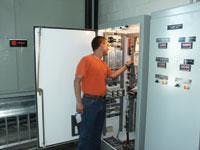Telemetry no Gamble for Water District
The Las Vegas Valley Water District (LVVWD) was established in 1954 to provide potable water to the Las Vegas Valley. The region has seen huge growth in recent years, more than doubling in size since 1980 with a current population exceeding two million. As the fastest growing metropolitan area in the country, a reliable water supply is essential to the area's residents, businesses and fire protection operations.
The LVVWD recently expanded its telemetry and control network to improve its ability to monitor system events, control remote equipment, and improve the efficiency of operations. The expansion improved communications coverage to outlying sites and established telemetry/control access at sites where data previously was collected manually.
In the new network, special attention was paid not only to data automation, but also to transporting the data to points in the system where it can be acted on by processing equipment or operating personnel.
When planning improvements to the communication network, LVVWD looked for a solution that was reliable, cost effective, and deployable with minimal disruption to existing services. Microwave Data Systems (MDS) was selected to provide wireless equipment for this program, including transceivers, antennas, InSite 6i management software, and ancillary equipment.
MDS has a relationship with the LVVWD that dates back to the late 1980s when the first generation wireless equipment was installed at the utility. Then, as now, MDS worked closely with district personnel to define equipment needs, assist with installation planning, and oversee system startup.
Operations Center
The heart of the LVVWD system is the Operations Center building, constructed in the summer of 2000. The building was designed with special consideration for data communication needs. Dedicated rooms are provided for radio equipment, SCADA computer equipment, and monitoring/control activities. This approach resulted in a quality installation from the ground up, rather than a "patchwork" arrangement where compromises might otherwise have been necessary. The design also provides ample room for expansion or configuration changes.
The LVVWD Operations Center gives operators immediate access to system-wide data. It is the "nerve center" of the water distribution network.
Telemetry, Control
The LVVWD network collects data parameters such as water pressure, rate-of-flow, chlorination levels, temperatures and pump status from nearly every part of the water system and reports it to the Operations Center via wireless. In addition, outbound control commands can be issued to activate pumps and valves, or to download programs into remote equipment.
Another critical function of the wireless network is to carry security signals between the LVVWD Operations Center and many remote facilities. In the event an alarm is generated at any site (fire, intrusion, operational alert, etc.) the appropriate crews can be dispatched to investigate and resolve the problem as quickly as possible.
MDS Equipment
At the heart of the communications system are MDS 9790 master stations and MDS 9710 remote radios deployed at field sites, repeater locations and the LVVWD Operations Center. Approximately 100 spread spectrum (license-free) transceivers are also installed in the system to monitor water usage at golf courses.
Remote sites are typically equipped with directional Yagi antennas aimed at the associated master or repeater station. Master stations employ an omni-directional antenna to provide equal response to surrounding remote stations. To provide the most robust connectivity possible, many sites are equipped with redundant equipment and backup power sources, a standard feature built into many MDS products.
Looking Forward
The LVVWD currently operates one of the most advanced data telemetry networks in North America, but it is not resting on its laurels. The utility is also testing new Ethernet-based wireless solutions that will add additional capabilities and functions to its system. Microwave Data Systems has provided the utility with new-generation MDS iNET 900™ wireless IP/Ethernet transceivers for this purpose.
IP offers distinct advantages over serial communication, including hardware and software platform interoperability, data collision avoidance, high transmission efficiency, and the ability to enroll new devices in a network without disrupting traffic flow. The use of IP also opens new possibilities for integrating a utility-wide Intranet, the World Wide Web and/or video into a network control scheme. Video, in particular, has strong potential in public utilities for security applications.
The MDS iNET transceiver is capable of handling multiple users and protocols in both new and legacy networks, eliminating the need to dismantle existing equipment to gain the advantages of IP signaling.
Conclusion
Readers interested in more information about wireless applications for SCADA/telemetry, security monitoring or other data communication needs can contact Microwave Data Systems, 175 Science Parkway, Rochester, NY 14620 (Tel. 585-242-9600). Additional information can also be found on the firm's website at www.microwavedata.com.



